Current Events :











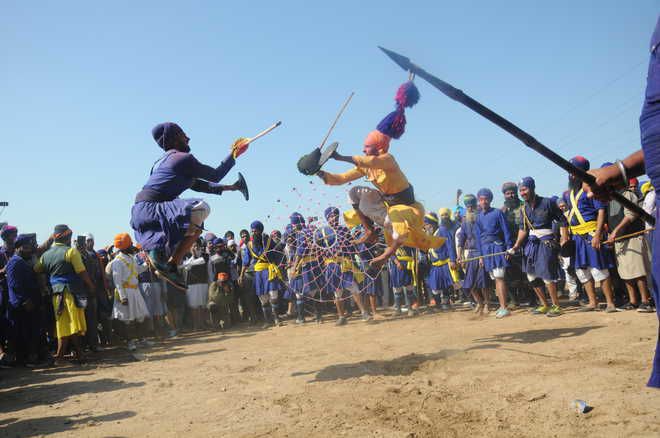
London, March 22
The British Army celebrated the Sikh festival of Holla Mohalla with several British Sikh officers from the Defence Sikh Network (DSN) organising the annual spring festivities that showcase the spirit of courage, preparation and readiness.
The festival dates back to the 18th century when it was initiated by Guru Gobind Singh as a celebration of military prowess during which martial skills are honed and exhibited in fierce but well-natured competition.
This year’s British Army Sikh Holla Mohalla event took place at the Ash Ranges in Hampshire, south-east England, on Tuesday and involved traditional games such as tug of war as an ode to the military forebears who played these games.
Defence Sikh Network said its members, mainly the soldiers from the British Army, celebrated the Sikh Military Festival by taking part in the military shooting competition, traditional Sikh martial arts and traditional Sikh military games and finally finished the festival with rang, the throwing of coloured powder as a mark of victory.
The network is the official organisation within the UK’s Ministry of Defence (MoD) that supports inclusion from a Sikh perspective. The network said the festival particularly resonates with the Sikhs within the country’s armed forces and, therefore, it began celebrating it in the British Army in 2021.
“We feel this should be one of the premier events in the Sikh calendar to ensure our martial tradition continues. This event is a celebration of our longstanding tradition of Sikh military culture and values,” the Defence Sikh Network said.

Naseer Ganai
Srinagar, March 23
After facing criticism from political parties, the Army on Saturday cancelled a seminar that was aimed at creating awareness about the Uniform Civil Code (UCC) and other issues. Late on Friday evening, the Army had sent invitations to media houses for the seminar on ‘Navigating legal frontiers: Understanding Indian Penal Code 2023 and the quest for Uniform Civil Code”. The seminar was to be conducted at the Kashmir University Auditorium on March 26. Law Secretary Achal Sethi was scheduled to present a valedictory address. The Chief Justice of the High Court of J&K and Ladakh had to preside over as chief guest and Major General PBS Lambha, GOC, 31 Sub Area, was to present vote of thanks.
Code of conduct
Questioning the move, ex-CM and National Conference (NC) vice-president Omar Abdullah said, “Is it appropriate for the Army to get involved in the divisive issue of the Uniform Civil Code and that too in a sensitive area like Kashmir?”
“There is a reason the Army has remained apolitical and areligious. This ill-advised UCC seminar is a threat to both these basic tenets. Going ahead with this risks opening up the Army to charges of getting involved in the murky world of politics coupled with interfering in religious matters,” Omar tweeted.
It’s interference
This is continuation of the trend of Naya Kashmir and Akhir Kab Tak campaigns in which the Army is seen playing a partisan role and directly interfering in political affairs. —Najmus Saqib, PDP Spokesperson
Not appropriate
Is it appropriate for the Army to get involved in the divisive issue of the Uniform Civil Code and that too in a sensitive area like Kashmir? —Omar Abdullah, National Conference Vice-president
One of the topics of the legal awareness seminar was themed ‘Legal pluralism to discuss the challenges and benefits of moving from a system of diverse personal laws to a uniform legal code considering the concept of legal pluralism’. Another topic was ‘Secularism and social harmony, explore how a uniform civil code aligns with the principles of secularism and its potential impact on fostering social harmony in a diverse society’. Another topic was ‘Human rights perspective, discuss the human rights perspective examining how a uniform civil code may contribute to upholding individual rights and freedom’.
Overview of the Bharatiya Nyay Sanhita 2023, victim’s rights and Bharatiya Nyay Sanhita 2023, and challenges and future directions were other topics.
NC’s chief spokesperson Tanvir Sadiq urged the Election Commission of India (ECI) to “assess the appropriateness of the Army discussing an issue that figures prominently in the BJP’s manifesto” while the model code of conduct is in effect.
The Peoples Democratic Party (PDP) also criticised the Army for conducting the seminar. “What we are seeing is the continuation of the trend of Naya Kashmir and Akhir Kab Tak campaigns in which the Army as an institution was seen playing a partisan role and directly interfering in the political affairs of J&K,” PDP spokesperson Najmus Saqib said. Saqib said this is a “very dangerous trend” and is a “manifestation of larger systemic erosion of the Constitution”. After the backlash, the Army cancelled the event, saying it was due to implementation of the model code of conduct.
Srinagar-based defence spokesman Lieutenant Colonel Manoj Sahu said, “The legal awareness seminar on March 26 by Kashmir Jurist in Kashmir University has been cancelled due to implementation of the model code of conduct.”
Jammu, March 23
Army Chief General Manoj Pande on Saturday visited Jammu-based White Knight Corps and the forward areas along the LoC here, an official statement said. According to the Army’s Additional Directorate General of Public Information, the Chief of the Army Staff was briefed by commanders about the operational preparedness and the prevailing situation.
“The COAS commended all ranks for their unwavering commitment in exhibiting high standard of professionalism and maintaining a stable and secure environment in the region,” the ADGPI said on X.
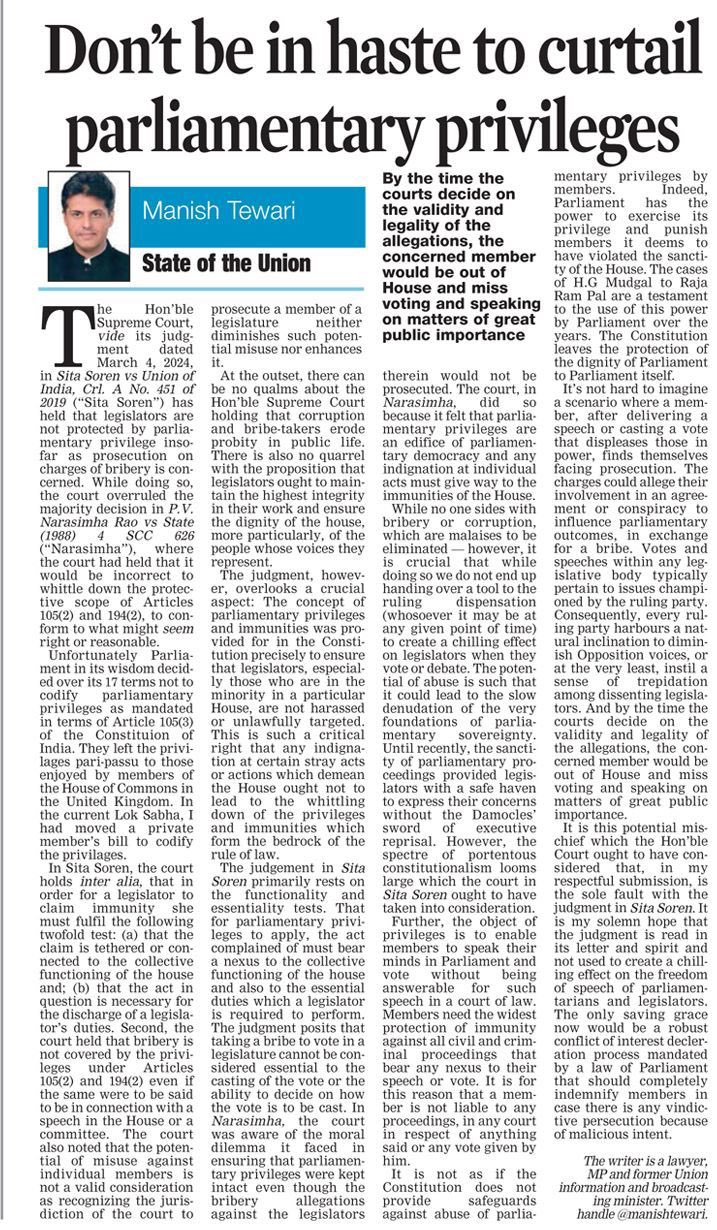
The Hon’ble Supreme Court, vide its judg ment dated March 4, 2024, in Sita Soren vs Union of India, Crl. A No. 451 of 2019 (“Sita Soren”) has held that legislators are not protected by parlia mentary privilege inso far as prosecution on charges of bribery is con cerned. While doing so, the court overruled the majority decision in P.V. Narasimha Rao vs State (1988) 4 SCC 626 (“Narasimha”), where the court had held that it would be incorrect to whittle down the protec tive scope of Articles 105(2) and 194(2), to con form to what might seem right or reasonable. Unfortunately Parlia ment in its wisdom decid ed over its 17 terms not to codify parliamentary privileges as mandated in terms of Article 105(3) of the Constituion of India. They left the privi lages pari-passu to those enjoyed by members of the House of Commons in the United Kingdom. In the current Lok Sabha, I had moved a private member’s bill to codify the privilages. In Sita Soren, the court holds inter alia, that in order for a legislator to claim immunity she must fulfil the following twofold test: (a) that the claim is tethered or con nected to the collective functioning of the house and; (b) that the act in question is necessary for the discharge of a legisla tor’s duties. Second, the court held that bribery is not covered by the privi leges under Articles 105(2) and 194(2) even if the same were to be said to be in connection with a speech in the House or a committee. The court also noted that the poten tial of misuse against individual members is not a valid consideration as recognizing the juris diction of the court to prosecute a member of a legislature neither diminishes such poten tial misuse nor enhances it. At the outset, there can be no qualms about the Hon’ble Supreme Court holding that corruption and bribe-takers erode probity in public life. There is also no quarrel with the proposition that legislators ought to main tain the highest integrity in their work and ensure the dignity of the house, more particularly, of the people whose voices they represent. The judgment, howev er, overlooks a crucial aspect: The concept of parliamentary privileges and immunities was pro vided for in the Consti tution precisely to ensure that legislators, especial ly those who are in the minority in a particular House, are not harassed or unlawfully targeted. This is such a critical right that any indigna tion at certain stray acts or actions which demean the House ought not to lead to the whittling down of the privileges and immunities which form the bedrock of the rule of law. The judgment in Sita Sorenprimarily rests on the functionality and essentiality tests. That for parliamentary privi leges to apply, the act complained of must bear a nexus to the collective functioning of the house and also to the essential duties which a legislator is required to perform. The judgment posits that taking a bribe to vote in a legislature cannot be con sidered essential to the casting of the vote or the ability to decide on how the vote is to be cast. In Narasimha, the court was aware of the moral dilemma it faced in ensuring that parliamen tary privileges were kept intact even though the bribery allegations against the legislators therein would not be prosecuted. The court, in Narasimha, did so because it felt that parlia mentary privileges are an edifice of parliamen tary democracy and any indignation at individual acts must give way to the immunities of the House. While no one sides with bribery or corruption, which are malaises to be eliminated — however, it is crucial that while doing so we do not end up handing over a tool to the ruling dispensation (whosoever it may be at any given point of time) to create a chilling effect on legislators when they vote or debate. The poten tial of abuse is such that it could lead to the slow denudation of the very foundations of parlia mentary sovereignty. Until recently, the sancti ty of parliamentary pro ceedings provided legis lators with a safe haven to express their concerns without the Damocles’ sword of executive reprisal. However, the spectre of portentous constitutionalism looms large which the court in Sita Sorenought to have taken into consideration. Further, the object of privileges is to enable members to speak their minds in Parliament and vote without being answerable for such speech in a court of law. Members need the widest protection of immunity against all civil and crim inal proceedings that bear any nexus to their speech or vote. It is for this reason that a mem ber is not liable to any proceedings, in any court in respect of anything said or any vote given by him. It is not as if the Constitution does not provide safeguards against abuse of parlia mentary privileges by members. Indeed, Parliament has the power to exercise its privilege and punish members it deems to have violated the sancti ty of the House. The cases of H.G Mudgal to Raja Ram Pal are a testament to the use of this power by Parliament over the years. The Constitution leaves the protection of the dignity of Parliament to Parliament itself. It’s not hard to imagine a scenario where a mem ber, after delivering a speech or casting a vote that displeases those in power, finds themselves facing prosecution. The charges could allege their involvement in an agree ment or conspiracy to influence parliamentary outcomes, in exchange for a bribe. Votes and speeches within any leg islative body typically pertain to issues champi oned by the ruling party. Consequently, every rul ing party harbours a nat ural inclination to dimin ish Opposition voices, or at the very least, instil a sense of trepidation among dissenting legisla tors. And by the time the courts decide on the validity and legality of the allegations, the con cerned member would be out of House and miss voting and speaking on matters of great public importance. It is this potential mis chief which the Hon’ble Court ought to have con sidered that, in my respectful submission, is the sole fault with the judgment in Sita Soren. It is my solemn hope that the judgment is read in its letter and spirit and not used to create a chill ing effect on the freedom of speech of parliamen tarians and legislators. The only saving grace now would be a robust conflict of interest decler ation process mandated by a law of Parliament that should completely indemnify members in case there is any vindic tive persecution because of malicious intent. The writer is a lawyer, MP and former Union information and broadcast ing minister. Twitter handle @manishtewari.
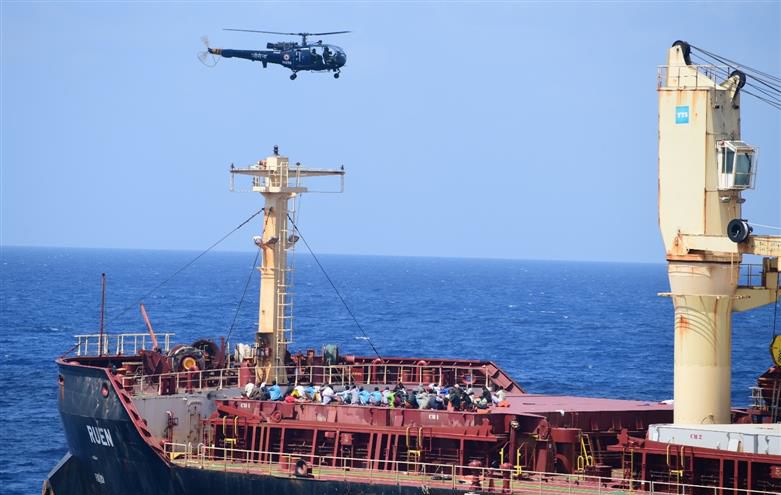
THE joint efforts made by the Indian Air Force (IAF) and the Indian Navy to free the merchant vessel MV Ruen from pirates in the Arabian Sea recently are a shining example of effective maritime security measures and inter-service collaboration. The successful operation saw the IAF’s C-17 heavy-lift aircraft execute a precision airborne drop of two combat boats and the Navy’s MARCOS commandos. Despite the hostile conditions, the IAF’s swift response and delivery played a crucial role in backing the Navy. This resulted in the surrender of 35 pirates and the release of the vessel and its crew. The proactive stance of the Navy, supported by the deployment of warships like INS Kolkata and INS Subhadra, demonstrates India’s readiness to safeguard global trade routes.
This isn’t the first time the Navy has showcased its capabilities in combating piracy. Over the years, it has undertaken a number of successful operations, including the rescue of the MV Suez in 2011 and thwarting piracy attempts in the Gulf of Aden in 2017. These actions not only protect the interests of the shipping industry but also contribute to international efforts towards maintaining peace and security at sea.
The Navy’s approach is in line with international conventions such as the United Nations Convention on the Law of the Sea (UNCLOS), which provides the legal framework for combating piracy and ensuring the safety of navigation in international waters. By adhering to the UNCLOS and collaborating with global partners, India has reaffirmed its commitment to upholding maritime law and order and cemented its place as the first responder on the high seas. As piracy continues to pose a threat to shipping trade, India’s timely operations serve as a model for other nations.
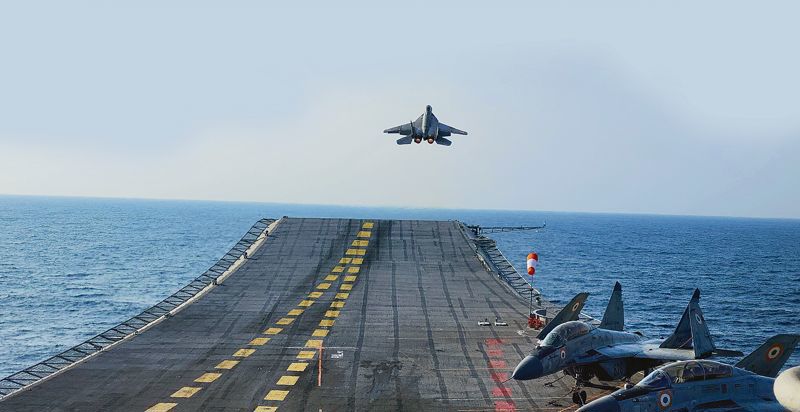
Ajay Banerjee
THE enhancement of the Indian Navy’s capabilities, announced in the first week of March, signals an expansion matching New Delhi’s strategic aspirations in the Indian Ocean. It is also an indication of India’s immediate and long-term maritime objectives.
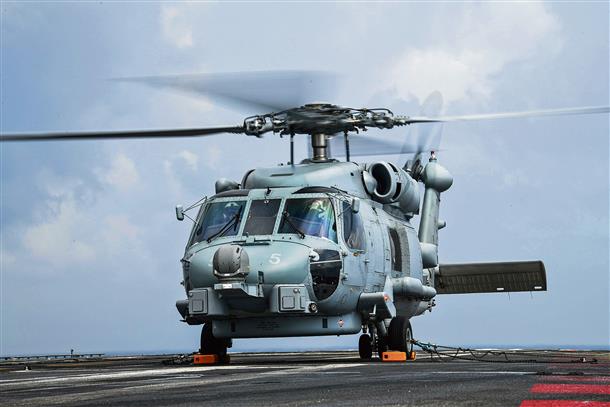
Karwar in northern Karnataka got a major infrastructure boost and is now the biggest naval base of the country. The latest technology-capable submarine-hunting helicopters, the MH-60R, were commissioned at Kochi. A new base, INS Jatayu, got commissioned at Minicoy in Lakshadweep. It sits close to the ‘9 degree shipping channel’, the busiest sea route to Europe and the Middle East in its westerly direction and China, Japan, Korea, among others, to its east.
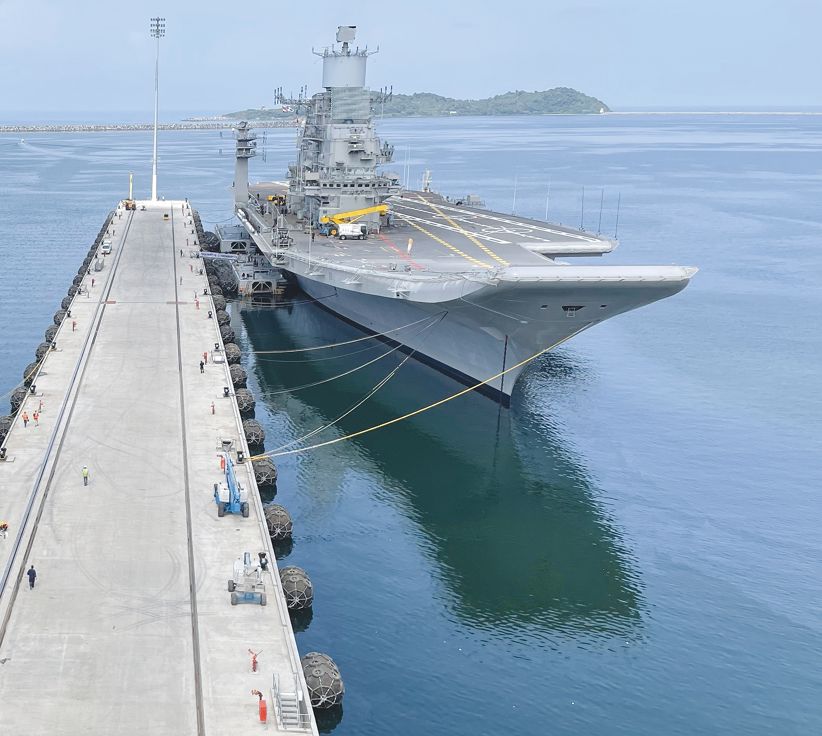
Amid this, the Navy carried out simultaneous copter and jet flying operations from both aircraft carriers — the INS Vikramaditya and INS Vikrant — for Defence Minister Rajnath Singh to assess the readiness. Twin-carrier operations have been done in the past, the most recent being in June last year. However, this time, INS Vikrant has been fully integrated with the rest of the fleet and its final flight integration is being done.
Also, after June last year, the Vikrant underwent a re-fit and re-started sailing in January. Medium-range surface-to-air missiles Barak-8 and MF-STAR (multi-function surveillance, track and guidance radar) have been fitted. The MF-STAR detects airborne threats like aircraft, anti-ship missiles and cruise missiles; the Barak-8 missile can shoot these at ranges of 80 km or more.

Expansion of Karwar base
Called Project Seabird, it is spread across 25 km and is being carried out in phases. The first phase was designed to accommodate 10 ships and it concluded in 2011. Phase II-A was okayed by the Cabinet Committee on Security in December 2012 to allow berthing of 32 ships and submarines, along with 23 yardcraft.
On March 5, Defence Minister Rajnath Singh, among other things, opened a 550-metre-long pier — that juts out into sea — to allow both aircraft carriers to berth at the same time at Karwar.
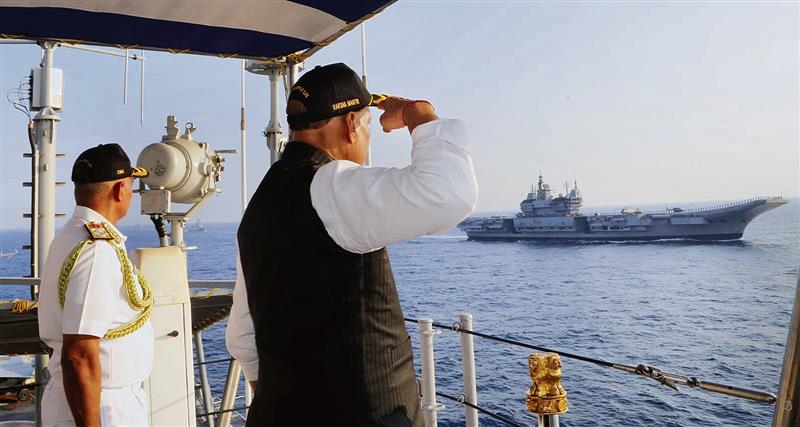
The INS Vikramaditya and INS Vikrant are the biggest warships in the fleet, each weighing close to 50,000 tonnes. The Vikramaditya is 284 metres long while the Vikrant is 262 metres long. The warships need a specific depth of water near the coast, while the length of the jetty and the pier needs to match their sizes when they dock for routine maintenance.
So far, Karwar had the facility to take in one carrier. The Cochin Shipyard has a facility to berth another carrier, but that is not a naval facility.
Vice Admiral Ravneet Singh (retd), former Deputy Chief of the Navy, who was Director General of Project Seabird for almost two years from 2018, says, “Things have made rapid progress. This is the biggest base for the Navy and will be its third operational base on the west coast.”
Phase II-A has a berthing space for ships and submarines that is collectively about 6 km in length. These jetties have technical facilities, electrical substations, switch gears and support utilities.
The latest Scorpene submarines will get a covered jetty to prevent enemy satellites from seeing how many subs are at base and how many are out at sea. A similar covered jetty exists on the east coast at Visakhapatnam.
Among the facets at Karwar is a covered dry berth, standing at a height of 75 metres, taller than the Qutub Minar in Delhi, and spread over 33,000 square metres to facilitate simultaneous maintenance of four frontline ships.
Phase II-A will also have four townships encompassing residential accommodation, with about 10,000 dwelling units for officers, sailors and civilian staff. The hospital is being upgraded to have 400 beds.
“The upcoming greenfield dual-use Naval Air Station with a 2.7-km runway will provide air support to the Navy aircraft and facilitate operations of commercial aviation,” adds Admiral Ravneet Singh.
The Navy hopes to ink its contract in a year and plans to have a fully operational airfield in four years.
About 90 per cent of the materials and equipment are being sourced from within the country. The project’s execution involves Indian infrastructure leaders such as AECOM India Ltd, Larsen & Toubro, ITD Cementation India Ltd, Nagarjuna Construction Company, Navayuga Engineering Company Ltd and Shapoorji Pallonji Group.
The latest copters
Indian Navy’s first MH-60R squadron has been commissioned as INAS 334 ‘Seahawks’ at INS Garuda, Kochi. This brings transformational anti-submarine (ASW) and anti-surface warfare (ASuW) capabilities to the Indian Navy. China has a fleet of some 60 such under-sea submarines that often trawl the Indian Ocean.
The helicopters would widen the arc of Navy’s capabilities, extending its operational reach. Vice Admiral Biswajit Dasgupta (retd), a former Eastern Navy Commander, says, “The helicopters will substantially enhance the combat power of our fleets in the coming days. They are of proven design and will become the mainstay of the Navy’s ship-borne air operations across warfare domains such as anti-submarine warfare, anti-ship warfare and surveillance, besides other lower-end roles.”
The copter uses a performance-based logistics programme for the US Navy which enables 95 per cent flight readiness and availability of the copter — a rate unmatched by other maritime helicopters. The US Navy and its allies use the same copter. Secondary roles for the copter include naval surface fire support, medical evacuation, search and rescue, logistics, special warfare, intelligence, surveillance and reconnaissance.
MH-60R is built based on four decades of operational experience of US company Lockheed Martin. India and the US signed a 24-copter contract in February 2020 at a cost of nearly Rs 14,000 crore under the framework of foreign military sales. All 24 helicopters are scheduled for delivery by 2025.
The helicopter is the maritime variant of the Blackhawk helicopter used by US forces. The Blackhawk was famously used by the US in an air raid in May 2011 to kill Osama bin Laden in Abbottabad, Pakistan.
Upgrade over Kamov
The Indian Navy, so far, is using the Russian origin Kamov-28 copters for anti-submarine roles. The Kamov is more than three decades’old technology but is equipped with torpedoes, depth charges and the copters have been with the Navy for almost 25 years.
Comparing the MH-60R with Kamov-28, Admiral Ravneet Singh says, “As compared to MH-60R, the Kamov, in its present configuration, lags behind in operational effectiveness as its equipment now falls under vintage technology. The Kamov, due to its size and weight, can be operated from very limited frontline ships. The availability of spares and the maintenance have been a challenge. It does not have the capability to dunk sonars at sea at night, which is a big capability gap.”
The technical life extension of the Kamov is being done in Russia and it’s being upgraded with an advanced maritime mission suite being added in India. The modernisation package includes the integration of advanced mission systems, sensors and avionics, anti-ship missiles as well as other weapons and also sonar dunking ability at night.
Watching shipping lanes
The Minicoy Island is the southern-most island of Lakshadweep, situated at a distance of 398 km south-west of Kochi. The Minicoy sits south of the 9 degree shipping channel. Maldives is just 130 km further south of Minicoy.
The INS Jatayu, that was commissioned by Navy Chief Admiral R Hari Kumar, has advanced surveillance capabilities. New jetties, an airfield and BrahMos supersonic cruise missiles are to be added.
The BrahMos missiles, with their latest versions being able to strike 500 km away, will enhance India’s ability to deter potential threats and safeguard vital shipping lanes.
The establishment of a naval base at Minicoy will augment connectivity with the mainland, focusing on comprehensive development of the islands.
Bolster maritime security
Development of our islands for maritime security should have been done decades ago. The US and France have strong island bases like Hawaii and Reunion, respectively. If India does not strengthen the Andaman and Nicobar Islands manifold and rapidly develop Lakshadweep and Minicoy to bolster maritime security, it would be throwing away the strategic advantage bestowed by geography. Vice Admiral Biswajit Dasgupta (Retd)
Admiral Dasgupta says, “We must bring with it a rapid development of staging or turnaround facilities for naval ships and aircraft. Only then will it provide benefits in terms of forward surveillance, presence and extended reach.”
Customarily, Indian Navy’s air stations are named after birds of prey. So one would expect an airfield to come up in quick time at Minicoy, that will allow the Navy to operate its patrol and remotely-piloted aircraft, avers Admiral Dasgupta.
How MH-60R functions
New Delhi, March 20

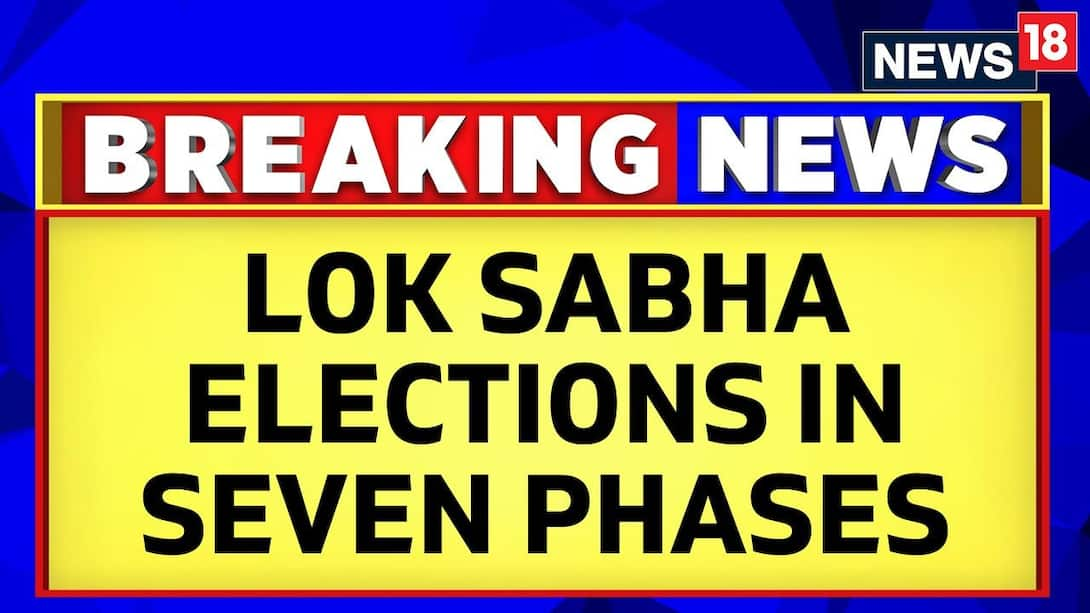
The nomination process for 102 parliamentary constituencies spread across 21 states and Union territories, where polling would be held in the first phase of the Lok Sabha elections on April 19, began on Wednesday with the issuance of a notification.

According to the notification issued by the Election Commission on behalf of the President, the last date for filing nomination papers is March 27.
However, due to a festival, March 28 is the last date for filing nominations for the Lok Sabha seats in Bihar going to polls in the first phase. Voting in four out of 40 seats in Bihar will be held in the first phase.
Nomination papers will be scrutinised on March 28. For Bihar, it would be done on March 30.
The last date for withdrawal of candidature is March 20 while for Bihar, it is April 2.
The elections to the 18th Lok Sabha will begin on April 19 followed by subsequent phases on April 26, May 7, May 13, May 20, May 25 and June 1. The counting of votes is on June 4.
The states where polling would be held in the first phase are Arunachal Pradesh, Assam, Bihar, Chhattisgarh, Madhya Pradesh, Maharashtra, Rajasthan, Tamil Nadu, Uttar Pradesh, West Bengal, Jammu and Kashmir, Lakshadweep and Puducherry.
Ever since the Electoral Bond story has exposed the role of law enforcement agencies in targeting corporates and forcing them to invest in EBs I’ve been wondering is there a parallel anywhere in the world
Then it came to my mind that a parallel extortion business is also in the news. The gangsters sitting abroad threatening rich people to pay. Some also operate from Indian jails. And some of these gangsters sitting abroad, are at times branded terrorists.. But they gave an idea to emulate.
I think the business of extortion has been learnt by our law enforcement agencies from these gangsters. ED played biggest role in this extortion. No wonder the previous Director ED was given many extensions. Probably because this was his brainchild. So ED gave an official platform to the EBs. You can call EB Electoral Bonds or Extortion Bonds and wow, ED too has an E as the first letter in it’s name. Now you can call this E whatever you want.
To:
Hon’ble Prime Minister India
Shri Narendra Modi Ji
7, Lok Kalyan Marg, New Delhi-110011 3rd March 2024
Respected Sir,
Subject Petition for Two Murder Investigations. ‘Conspiracy of Double-Murder’ in Food & Drug Administration Office at Kharar, District SAS Nagar (Mohali) in Punjab on 29.3.2019; For ten thousand crore rupees Scam by Embezzlement of 150 crore(till date) Buprenorphine Tablets. Neha Shoree, Drug Licensing Authority cum-Punjab State Flying Squad Head; was murdered in her Office Seat at 11:33 AM. Her planted killer was also murdered within the next two minutes.
1.We submit that a double murder plan was executed by the Drug Mafia with the support of Punjab Civil Administration. A peddler Balwinder Singh of Morinda was identified & planted for murder of Ms. Neha Shoree. On 10.3.2019, the Election Commission had imposed the Model Code of Conduct for 17th Lok Sabha Elections, i.e., on Sunday. Balwinder Singh had been hired for murder of Neha Shoree. He was granted Revolver License & Ammunition illegally, and on 12.3.2019 after the imposition of Model Code; for murder of Neha Shoree: a topper and meritorious Lady Officer.
2.The Drug Mafia was making a huge profit of thousands of crores of rupees by selling Buprenorphine Naloxone tablets and many other Drugs at exorbitant prices to the youth in Punjab. During 2017, her controller, Joint Commissioner (Drugs) Mr. Pardeep Mattoo; instructed Neha Shoree to check the drugs proliferation and particularly, the Drug De-addiction Centers for tablets’ pilferage for sales outside. He asked her to assist the visiting Center’s Teams in their inspections of the De-addiction Centers. Neha Shoree pointed at embezzlement of Buprenorphine Naloxone tablets by regular pilferage from about 800 registered De-addiction Centers & OOAT clinics, and from thousands of private unregistered centers & village shops. She apprised Mr. Mattoo about the Drug Menace in detail. As directed by him, she submitted her investigation report in writing to Mr. Mattoo with complete details on the functioning of Sidhu De-addiction Center at Kharar. Politicians perceived Neha Shoree as an impediment in their commercial and electoral gains from Drugs’ Businesses during the impending Lok Sabha elections. Mr. Mattoo, in collusion with the authorities in power connived for Ms. Neha Shoree’s murder in her Office Seat.
3.DGP of Punjab formed four SITs in a short span of twelve days. We immensely cooperated with all the SITs of Punjab Police. But all along, we were misled; kept in dark and deceived. We provided password details of our daughter’s iPhone to the SIT: only to discover later that the data of her iPhone had been deleted. SIT took out its SIM card and did not return it with her iPhone. Forensics of Cyber and Ballistic reports were abnormally delayed. (Forensic expert’s examinations started after a delay of 103 days, Ballistic started after 131 days and Cyber examination started after 41 days: and only to obliterate the leftover proofs, if any). All investigations were botched-up despite our relentless & vigorous co-operation, and follow-up. Four months after our Petition to HHC on 07.11.2019, the SIT supplied its investigation report to us on 24.02.2020. SIT had surreptitiously closed it in January 2020, i.e., ten months after the two Murders: as untraced. SIT gave us its report on 24.2.2020, i.e., eleven months after this Double-Murder. SIT’s report is Blank.
4.Neha Shoree was shot dead in her office seat in less than ten seconds. Balwinder Singh was shot dead at a distance of 120 yards within two minutes of murdering Neha Shoree. This Double-Murder operation was extraordinarily swift due to prior elaborate planning with precision.
5.Since Nov 2019, our petition No. CRM-M-48105/2019 is lurking in Hon’ble P&H High Court. Technically, the petition is not sub-judice because no FIR is existing; and nor HHC has given any orders for registration of the FIR since January 2020. We humbly request that Honorable Courts may kindly avoid partiality and discrimination in the Justice systems and its delivery to the common Citizens. All authorities of the Nation are evading responsibility under the misnomer of sub-judice, which has thwarted the Justice itself.
6.We humbly request your honor to order for two separate investigations into these two murders by the CBI, and by the other relevant &Constitutionally mandated Central Agencies which deal with the crimes related to Drugs: and the crimes related to the Security of our border States. We attach a copy of the letter dated 16.4.2019 of the then Health Minister Shri Brahm Mohindra to the then Chief Minister, Capt. Amarinder Singh for your perusal.
7.Neha Shoree has orphaned her (then) two years old baby girl.
8.We humbly request your honor for Justice.
Thanking you in anticipation
Yours sincerely
Captain (Retd)Kailash Kumar Shoree (Father of the deceased, 1971 War Veteran) Mob-8146668502.
Mrs. Arun Shoree (Mother of the deceased, retired teacher) Mobile No-7087400392.
Residence #267, Sector-12, Panchkula-134112. (0172-4084267)

























































